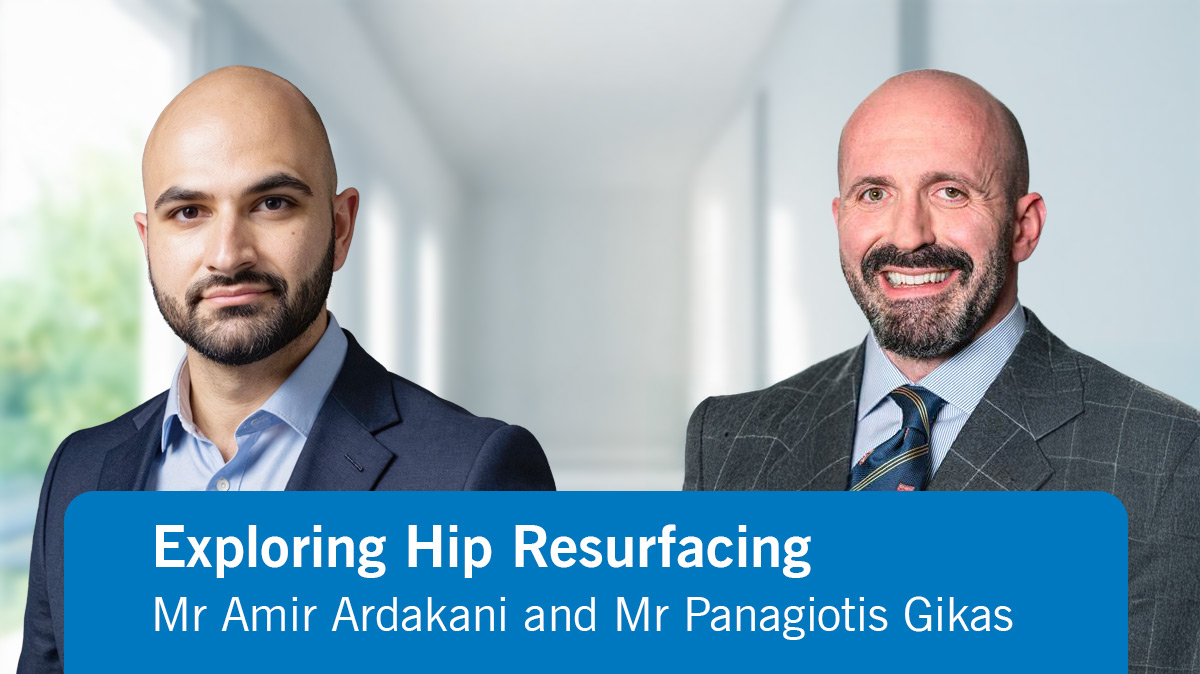Exploring Hip Resurfacing with Mr Panos Gikas and Mr Amir Ardakani

In this episode, Mr Panos Gikas, Consultant Orthopaedic Surgeon, joins host Mr Amir Ardakani, Orthopaedic Registrar and hip and knee fellow at Cleveland Clinic London, for an in-depth discussion on hip resurfacing.
Hip resurfacing has long divided opinion within the orthopaedic community, often judged by revision rates, early implant designs, and variable surgical techniques. However, when outcomes such as functional recovery, proprioception, and load distribution are considered, the procedure presents a very different story.
Together, they examine the latest evidence, the key differences between hip resurfacing and hip replacement, and what these mean for patients seeking to return to active lifestyles. This conversation provides valuable insights into a procedure that continues to evolve, and the circumstances in which it may offer unique benefits.
Register for our Modern hip resurfacing: Technique, innovation, and global perspectives conference here.
Visit the Cleveland Clinic London website to learn more about our orthopaedic services and personalised hip care.
If you found this episode valuable, please consider subscribing, leaving a review, and sharing it with someone who may benefit.
Exploring Health is supported by Cleveland Clinic Philanthropy UK and is available on all major streaming platforms, including YouTube.
Subscribe: Apple Podcasts | Podcast Addict | Spotify | Buzzsprout | YouTube
Exploring Hip Resurfacing with Mr Panos Gikas and Mr Amir Ardakani
Podcast Transcript
Mr Amir Ardakani
Welcome to this episode of Exploring Health with Cleveland Clinic London. I'm your host, Amir Ardakani, I'm an Orthopaedic Registrar and I'm currently a hip and knee fellow at the Cleveland Clinic in London. Today we're diving into a procedure that's long divided opinion in the world of hip surgery, and that's hip resurfacing. Once a rising star, then shadowed by metal on metal complication, resurfacing is now being re-examined not because it's fashionable, but because now we have new, compelling evidence. Joining me today is Mr Panos Gikas, a Consultant Orthopaedic Surgeon at the Cleveland Clinic in London. He brings extensive experience in the world of anterior hip approaches, joint preserving techniques and also implant design. And here's why we think all this matters, for years resurfacing has been evaluated through the lens of revision rates, poor implant designs and suboptimal surgical technique. But, if we shift the question to functional recovery symmetry, proprioception, load distribution, then we start to see that hip resurfacing behaves quite differently. Recent data from Gate Labs and pervasive monitoring is beginning to show that difference is measurable in all these terms and we feel that this definitely warrants further exploration and insight. This October, the Cleveland Clinic Hip conference, which is led by Professor Justin Cobb and Mr Gikas, will focus entirely on the modern resurfacing. The techniques, the controversies and all the evidence that underlies it and today we're setting the stage for that discussion. So, Mr Gikas, I want to start by asking you why you think that resurfacing is back on the radar in 2025?
Mr Panos Gikas
Amir, it is indeed a great pleasure to be here today with you to discuss a very important topic which is hip resurfacing and the upcoming conference that we're going to be doing at Cleveland Clinic London in October. To answer your question quickly, the reason why we are seeing a comeback of resurfacing is because simply function matters. We know that patients care about how they move, how they feel and how they perform. And we are seeing that the patients who undergo hip resurfacing can have a more symmetrical gait, they have better proprioception and better function overall compared to stemmed total hip replacements. And that's not just my opinion or the opinion of people who perform hip resurfacing, this is evidence which is based on gait analysis and population data that currently are shifting the conversation back to why resurfacing should take a centre stage in younger patients who want better function and better outcomes.
Mr Amir Ardakani
But we've been here before and what's really changed over the last 20 years?
Mr Panos Gikas
Well, a couple of things have changed. First of all, the materials have changed more notably, the fact that we're moving away from the old-fashioned metal on metal hip resurfacings and we are introducing ceramic on ceramic bearing surfaces. So whatever worry there has been in the past in terms of the possible adverse effect of metal ions are no longer valid because we have better implants, newer implants with ceramic and ceramic bearing surfaces, that take away the issue of metal ions, take that out of the equation. We have to remember, of course, that whatever bad press hip resurfacing got in the past was based on a specific badly designed implant. There was nothing actually wrong with the hip resurfacing with the technique itself. The things that have changed nowadays is that we have better implants, better designed implants, ceramic on ceramic bearing surfaces, but also more importantly, we have better trained surgeons who know how to insert these processes at the right anatomical position in order to give the patients the better function, better longevity and reduce complication. But also, the last thing that I think that has changed and it's probably the most important thing is the fact that patient education has changed and patient demands have changed as well. On top of better designed implants, on top of better designed bearing surfaces, we have patients who come to us better educated with higher demands in terms of what functional outcomes they can achieve, and I think that's very important and not something that we can ignore.
Mr Amir Ardakani
So we've spoken here a lot about patients functioning better and patients wanting better function, especially on higher demand, younger or even elderly patients who want to get back to sports or kind of higher demand activities. But do we actually have the evidence to back these statements that hip resurfacing gives our patients better function?
Mr Panos Gikas
Yes, absolutely we do. Professor Justin Cobb, who is a leading research, at the moment at the musculoskeletal lab at Imperial College, and is also in charge of organising this upcoming conference at the Cleveland Clinic London, has shown clearly that when hip resurfacings are executed well, in well selected patients, they result in a more natural gait, a more normal gait, a better biomechanical gate with better function for the patients involved.
Mr Amir Ardakani
I completely agree, and I think there's evidence from pervasive monitoring and wearble data that's showing that actually resurfacing patients do actually function a lot, a lot better. So in your clinic, if you're selecting a patient, who would you say that resurfacing is actually for, is it for the young 50 year old male or is that indication slightly changing?
Mr Panos Gikas
I think typically, it's correct to say that hip resurfacings are generally for the younger population. The younger active population with good bone stock who want to maintain better movement and avoid restrictions in terms of their athletic activities. However, it's not always about age because obviously, nowadays older people in their 70s, 80s can still have a very good bone stock and they can still have high expectation in terms of their activities and the function they want to achieve. So I don't think nowadays we can strictly set an age limit in terms of when hip resurfacing is appropriate. I think each patient needs to be studied in their own merits. We need to assess, as I said, it is very important to assess the bone stock, it is very important to assess the expectations that the patient has in terms of the upcoming hip surgery and it is very important to discuss with the patient that pros, the advantages and potential disadvantages of the hip operation they are about to choose. We have to remember always that the two main advantages of hip resurfacing are first of all function and there is no doubt that function is better after hip resurfacing, he biomechanics of hip resurfacings are better compared to the biomechanics of total hip replacement, and the second advantage that hip resurfacing offers, particularly for the younger population, is the potential revision advantage in the future. Remember, hip resurfacing is generally an operation that we tend to favour for the younger, more active patients, and these are precisely the patients that are likely in their lifespan to need a further hip surgery in the future and therefore revising a hip resurfacing and converting it to a hip replacement in 15/20/30 years down the line, is a much easier operation to perform rather than revising a hip replacement surgery.
Mr Amir Ardakani
And I suppose if we are moving into the world of different materials such as ceramic on ceramic or even better metal on poly implants, these can be offered to smaller patients who couldn't get them before or even women who were excluded because of their size and because of the metal ion issues. And so we've discussed a lot about the benefits, I think we've heavily highlighted a lot of the benefits that hip resurfacing does offer, so why is it that many surgeons don't offer hip resurfacing in their routine practise?
Mr Panos Gikas
I think the answer to that is simple because it is a technically demanding procedure. It is a technically demanding procedure that needs precision in order to avoid any potential complications and in order to get the best outcome for your patient, both in terms of function but also in terms of longevity of the implant. Unlike any procedure you have to remember, there is a learning curve, okay, and the learning curve for hip resurfacing is steep and it needs to be done in a controlled manner under supervision of surgeons who have experience in order to avoid any complications during the process of the learning curve. Sadly, in the last 20 years, because of the bad press that hip resurfacing got in the past, in relation to a specifically badly designed implant, there are few surgeons around who have been trained to do hip resurfacing and therefore fewer surgeons that are able to support colleagues and younger trainees to take them through their learning curve. I think that's the biggest problem with hip resurfacing at the moment. But there is no doubt that if hip resurfacing is done well, under the supervision of well-trained surgeons and if they implant, the newer better design implants, are positioned well and accurately, there is absolutely no doubt biomechanically, that this is a better operation for the patient and offers the patient better function both in the short term and in the long term.
Mr Amir Ardakani
A topic that I find interesting that's also slightly relevant is surgical approach. Now I know you've recently changed your approach of last 5 to 10 years to become an anterior hip surgeon and a very good anterior hip surgeon. And there's a lot of talk about doing anterior hip resurfacing and it's causing a lot of excitement. Is this all just excitement and hype, or is there any genuine truth about anterior hip resurfacing and the benefits?
Mr Panos Gikas
Well, again, I think this is indeed a very exciting space. The anterior approach, as you know, if done well, it does reduce soft tissue trauma. It is a minimally invasive approach. It is a muscle sparing approach. And therefore aids recovery, both in the short term, but increasingly there are studies that show that anterior approach specifically because of the benefit in terms of preserving muscles, has a better long term outcome for the patients as well and better function in the long term. However, combining, undoubtedly combining the anterior approach with resurfacing is technically demanding, and that sets the technical bar even higher and probably makes the learning curve even steeper. We are not here to say that resurfacing can only be done through the anterior approach completely on the contrary, resurfacing is approach agnostic. In my view, undoubtedly the Holy Grail of hip arthritis surgery is hip resurfacing through the anterior approach precisely because hip resurfacing offers the biomechanical advantage compared to hip replacement and on top of that you add the soft tissue sparing advantage of the anterior approach. But that, by no means does it mean that hip resurfacing should only be done through the anterior approach. Hip resurfacing is technically demanding enough and the surgeons who opt to adopt hip resurfacing in their armamentarium of options offered to young patients with hip arthritis, should choose to do the hip resurfacing with the approach that they feel more safe performing. Whether or not you go down the route of anterior approach or posterior approach. This is open to discussion and there are advantages and disadvantages related to both approaches and I think this is a very exciting space, very exciting discussion that we're going to have during the upcoming conference that we are holding at the Cleveland Clinic London in October.
Mr Amir Ardakani
We're really looking forward to that debate. I think there's an anterior versus posterior debate. So, if you were going to choose a, I mean, would you personally do hip resurfacing for yourself or your family member if they needed a hip replacement?
Mr Panos Gikas
Absolutely, absolutely. If I have the right indications for hip resurfacing, there's no doubt I will opt for that. Again, without wanting to repeat myself, I will choose that because there is an amplitude of data and evidence out there confirming that hip resurfacing is a better biomechanical option, for younger patients that want better function and better athletic performance. Now the other thing I will choose is choose my surgeon well OK, because whether or not you opt for a total hip replacement or whether you opt for a hip resurfacing or indeed any surgical procedure, there are two things that you need to choose carefully. One is your surgeon and the other one is the institution where you perform the operation. At Cleveland Clinic London, we have probably one of the best private hospitals at the moment available in the United Kingdom in terms of technological offerings, in terms of state-of-the-art technology, in terms of low infection risk and so on and so forth. On top of that, you had the expertise of the surgeons working at Cleveland Clinic London, both in terms of offering the anterior approach, offering hip resurfacing, offering hip replacement and you have the best chances of getting a very good outcome and whether or not you choose hip replacement or hip resurfacing
Mr Amir Ardakani
OK. Just shifting focus a little bit, just tell me about this upcoming Cleveland Clinic hip conference. Is it only for surgeons who believe in hip resurfacing and nothing else?
Mr Panos Gikas
No, on the contrary, it is for everyone really, and for everyone who is interested in terms of innovation. For every surgeon who is interested to improve their practise or potentially considered changing certain aspects in the practise in order to provide a better outcome and better function for the patients. Hip resurfacing, we believe that it is a very good technique. We fully appreciate that there are limitations and during the upcoming conference we're going to discuss all aspects of hip resurfacing. Both the positives and the potential negatives, both the advantages and the potential disadvantages. And we are going to concentrate on evidence and base our discussions on data in order to be able to offer to both colleagues across the healthcare industry the best informed option in terms of what offerings patients have and in terms of how these patients, particularly the young patients can get the best possible functional outcomes when they are affected with pain and arthritis, limiting their function.
Mr Amir Ardakani
I've seen the programme that's already put out and it doesn't seem like a promotional event. It seems more of a serious kind of academic discussion and quite balances both sides very, very nicely and for attendees who are thinking about coming to the meeting, what do you think they'll take away from this meeting?
Mr Panos Gikas
I’m hoping that they will take away that the resurfacing definitely has a very important role in the future. That resurfacing nowadays needs to be considered as a valid option because of the better implants and the better bearing surfaces that we have to offer. And it is also, the other important message is that resurfacing is teachable. OK, so sadly, a lot of trainees that have come through their training in recent years have not been exposed to resurfacing, but that doesn't mean that resurfacing cannot be taught. That doesn't mean that these surgeons cannot be trained to perform resurfacing and by doing so, offer a safe, predictable outcome to their patients. The other thing which I think is very important that I hope the other important message that will come out of this meeting is that, it's not just about X-rays, it is about function as well. OK, as orthopaedic surgeons we have been concentrating overall throughout our training focusing on X-rays but we have to remember that X-rays of course are important, they give us a measure of what we have performed but they are static pictures. They do not take into consideration function. So we need to make sure that we choose our techniques, whether it is hip resurfacing as opposed to hip replacement and our approaches, whether it is anterior approach as opposed to other approaches. In a way that will allow us to have the better possible functional outcome for our patients, respecting soft tissues and respecting biomechanics.
Mr Amir Ardakani
Mr Gikas, thank you very much. That's given us quite a brilliant overview into the topic and I'm hoping it's giving us just a taste of what the conference will bring us. Is there anything you'd like to add before we finish?
Mr Panos Gikas
No, I mean I as I say it was great to be here today and great to be able to discuss a topic which is close to my heart. I really hope that a lot of people that hear this podcast, will be interested enough to attend the conference and learn more about the hip resurfacing and learn more why nowadays in 2025, hip resurfacing should definitely be a valid, safe, reproducible option for a large number of patients with arthritis. Thank you.
Mr Amir Ardakani
Thank you all. You've been listening to exploring health with Cleveland Clinic London. I've been your one off host, Amir Ardakani and it's been a pleasure to speak with Mr Gikas about the evolution of hip resurfacing and its place in modern orthopaedic practise. If you'd like to explore this topic further, join us at the Cleveland Clinic Hip Conference on the 3rd of October at the Berkeley Hotel, where surgeons, engineers and critics will debate what's next for resurfacing in an era of function focused care. All the details are found in the episode notes, and if you found this valuable, please subscribe and share it and thank you for all for listening.

Exploring Health with Cleveland Clinic London
Tune into Exploring Health for open conversations about health, wellness, and the latest medical advancements. Hosted by Mr Kash Akhtar, Consultant Orthopaedic Surgeon, each episode dives into key health topics with expert insights from Cleveland Clinic London specialists. Whether you’re a patient seeking answers, or healthcare professional looking to expand your knowledge, Exploring Health is your trusted source for engaging and informative discussions.This podcast was made possible by the support of Cleveland Clinic Philanthropy UK, the charity partner of Cleveland Clinic London.



